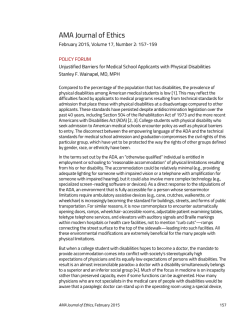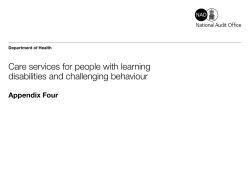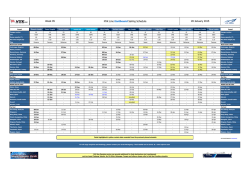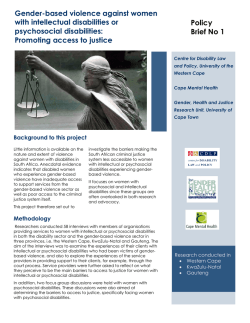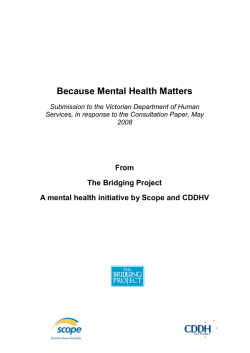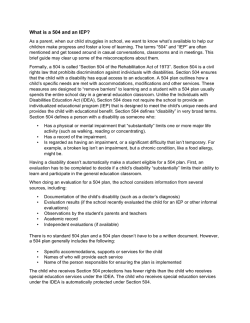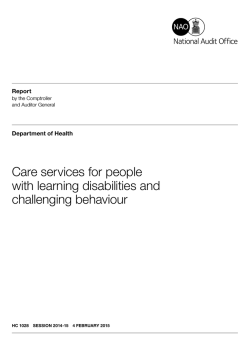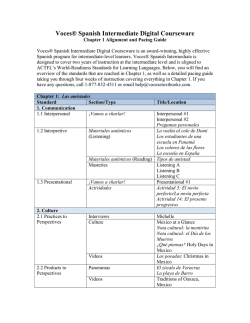
Shared Civil Rights Principles for the Reauthorization of the
Shared Civil Rights Principles for the Reauthorization of the Elementary and Secondary Education Act January 2015 Shared Civil Rights Principles for ESEA Reauthorization The United States has played a historic and critical role in promoting educational opportunity and protecting the rights and interests of students disadvantaged by discrimination, poverty, and other conditions that may limit their educational attainment. For more than five decades, Congress has consistently recognized and acted on the need to promote fair and equal access to public schools for: children of color; children living in poverty; children with disabilities; homeless, foster and migrant children; children in detention; children still learning English; Native children; and girls as well as boys. Much progress has been made, but educational inequality continues to quash dreams, erode our democracy, and hinder economic growth. This federal role must be honored and maintained in a reauthorized Elementary and Secondary Education Act (ESEA), which must ensure the following: I. Each state adopts college and career-ready state standards and provides: All students a fair and equal opportunity to meet these standards, including: • Access to early childhood education for economically disadvantaged children and those with disabilities (ages birth to 5 years). • Equal access to qualified and effective teachers and core college-prep courses. • Equal access to technology including hardware, software, and the Internet. • Safe and healthy school climate with inclusionary discipline best practices. • Supports and services needed by English learners and students with disabilities. • Protections for the most vulnerable children, e.g., those in juvenile or criminal justice systems, those in child welfare systems, pregnant/parenting students, and foster, homeless, and migrant youth. Annual, statewide assessments for all students (in grades 3-8 and at least once in high school) that are aligned with, and measure each student’s progress toward meeting, the state’s college and career-ready standards, and • Are valid and reliable measures of student progress and meet other requirements now in Sec. 1111(b)(3) of Title I.i • Provide appropriate accommodations for English learners, who should be exempt only for their first year attending school in the United States. • Provide appropriate accommodations for students with disabilities. • Limit alternate assessments based on alternate achievement standards only to students with the most significant cognitive disabilities, up to 1 percent of all students; terminate assessments based on modified achievement standards; and prohibit the use of Individualized Education Programs (IEPs) to measure academic achievement under ESEA. • Allow, during a transition period, alternatives to computer-based assessment for students in schools that have not yet provided them with sufficient access to, and experience with, the required technology. II. Federal dollars are targeted to historically underserved students and schools. • Title I is used to provide extra (supplemental) resources needed by high-poverty schools to close achievement gaps and improve student outcomes. • States, districts and schools serving the highest-need student populations receive more funding than others. • Targeted funding is provided to meet the needs of the most vulnerable children including youth in juvenile and criminal justice systems; Native American children; English learners; and foster, homeless, and migrant students. III. State accountability systems expect and support all students to make enough progress every year so that they graduate from high school ready for college and career. 2 Updated February 4, 2015 Shared Civil Rights Principles for ESEA Reauthorization • • States set annual district and school targets for grade-level achievement, high school graduation, and closing achievement gaps, for all students, including accelerated progress for subgroups (each major racial and ethnic group, students with disabilities, English language learners, and students from low-income families), and rate schools and districts on how well they meet the targets. Effective remedies to improve instruction, learning and school climate (including, e.g., decreases in bullying and harassment, use of exclusionary discipline practices, use of police in schools, and student referrals to law enforcement) for students enrolled are implemented in any school where the school as a whole, or any subgroup of students, has not met the annual achievement and graduation targets or where achievement gaps persist. The remedies must be effective both in improving subgroup achievement and high school graduation rates and in closing achievement gaps. IV. States and districts ensure that all Title I schools encourage and promote meaningful engagement and input of all parents/guardians –regardless of their participation or influence in school board elections – including those who are not proficient in English, or who have disabilities or limited education/literacy – in their children’s education and in school activities and decision-making. Schools communicate and provide information and data in ways that are accessible to all parents (e.g., written, oral, translated). V. States and LEAs improve data collection and reporting to parents and the public on student achievement and gap-closing, course-completion, graduation rates, school climate indicators (including decreases in use of exclusionary discipline practices, use of police in schools, and student referrals to law enforcement), opportunity measures (including pre-K and technology), and per-pupil expenditures. Data are disaggregated by categories in Sec. 1111(b)(3)(C)(xiii) of Title I,ii and cross-tabulated by gender. VI. States implement and enforce the law. The Secretary of Education approves plans, ensures state implementation through oversight and enforcement, and takes action when states fail to meet their obligations to close achievement gaps and provide equal educational opportunity for all students. Submitted by: The Leadership Conference on Civil and Human Rights Alliance for Excellent Education American-Arab Anti-Discrimination Committee American Association of University Women Association of University Centers on Disabilities Children's Defense Fund Council of Parent Attorneys and Advocates Democrats for Education Reform Disability Rights Education and Defense Fund Easter Seals Education Law Center-PA The Education Trust Gay, Lesbian & Straight Education Network Institute for Educational Leadership Lawyers’ Committee for Civil Rights Under Law League of United Latin American Citizens Mexican American Legal Defense and Educational Fund NAACP 3 Updated February 4, 2015 Shared Civil Rights Principles for ESEA Reauthorization NAACP Legal Defense and Educational Fund National Association of Councils on Developmental Disabilities National Center for Learning Disabilities National Congress of American Indians National Council of La Raza National Disability Rights Network National Indian Education Association National Urban League National Women's Law Center Partners for Each and Every Child Southeast Asia Resource Action Center TASH Teach for America Teach Plus TNTP United Negro College Fund Contact: Nancy Zirkin, Executive Vice-President, The Leadership Conference on Civil and Human Rights, [email protected], 202/466 3311. i This section includes requirements to ensure the quality, fairness and usefulness of the statewide assessments. For example, they must assess higher-order thinking skills and understanding; provide for the inclusion of all students (including students with disabilities and English language learners); be consistent with professional and technical standards; objectively measure academic achievement, knowledge and skills; and provide information to parents, teachers, principals, and administrators so that they can address the specific academic needs of students. ii This section requires assessment results “to be disaggregated within each State, local educational agency, and school by gender, by each major racial and ethnic group, by English proficiency status, by migrant status, by students with disabilities as compared to nondisabled students, and by economically disadvantaged students as compared to students who are not economically disadvantaged.” 4 Updated February 4, 2015
© Copyright 2026
